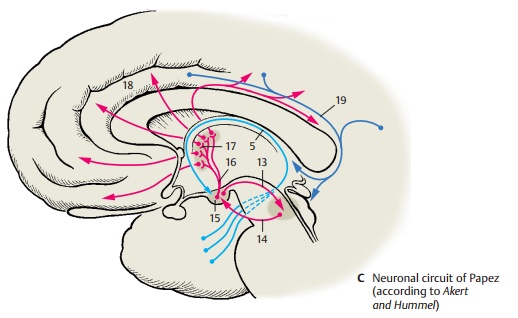Chapter: Human Nervous System and Sensory Organs : Functional Systems
Limbic System

Limbic System
Overview
The phylogenetically old parts of the telen-cephalon, together with its border zones and its connections to subcortical centers, are collectively known as the limbic system. It is not a circumscribed, topically organized system of pathways but rather a collection of functionally closely related nuclei and cortical areas. The system has also been called the visceral or emotional brain, a catchphrase highlighting its functional sig-nificance. As the concept of the limbic sys-tem is based on functional connections, its basic anatomical structures are only vaguely defined.
Subdivision (A)
The cortical regions belonging to the limbic system form a C-shaped complex on the medial aspect of the hemisphere that con-sists of theparahippocampal gyrus (A1), the cingulate gyrus (A2), and the subcallosal area (parolfactory area) (A3). The cingulategyrus, which is also calledlimbic gyrus, gave the system its name. An inner and an outer arch can be distinguished at the medial aspect of the hemisphere. The outer arch(parahippocampal gyrus, cingulate gyrus, and parolfactory area) is formed by the border zones of the archicortex (periarchi-cortex) and by the indusium griseum of thecorpus callosum (rudimentary archicortex). The inner arch consists of archicortical and paleocortical regions, namely, thehippo-campal formation (A4), the fornix (A–C5),the septal area (A6), the diagonal band ofBroca, and the paraterminal gyrus (A7). Animportant component is also the amyg-daloid body. Some subcortical nuclei withclose fiber connections to the limbic cortex are included in the system, such as the mamillary body, the anterior nuclei of thalamus, the habenular nucleus, and addi-tionally, in the midbrain the posteriortegmental nucleus, theanterior tegmental nucleus, and the interpeduncular nucleus.


Pathways (B, C)
The limbic system is connected with the ol-factory centers through several fiber bundles. The fibers of the lateral olfactory stria terminate in the cortical parts of the amygdaloid body.
The limbic system influences the hypo-thalamus via three pathways:
! The fornix, the precommissural fibers of which terminate in the preoptic area (B8) and in the nuclei of the tuber cinereum (B9)
! The terminal stria (B10), which runs from the amygdaloid body (B11) to the tuberal nuclei
! The ventral amygdalofugal fibers (B12)
The connection to the tegmental nuclei of the midbrain is established through the descending bundle of the habenular nu-cleus (habenulotegmental tract and habenulopeduncular tract) and through thepathways of the mamillary body (mamillarypeduncle and mamillotegmental fasciculus).The efferent mamillotegmental fasciculus (C13) and the afferent peduncle of the mamillary body (C14) form a neuronal cir-cuit.
Within the limbic system runs a multiple pathway, the neuronal circuit of Papez. The efferent fibers of the hippocampus reach the mamillary body (C15) through the for-nix (C5). Here the impulses are relayed to the bundle of Vicq d'Azyr (C16), which ex-tends to the anterior nuclei of thalamus (C17). The latter project to the cortex of the cingulate gyrus (C18), from where the cin-gulate fiber bundles (C19) return to the hip-pocampus.
Connections of the neocortex to the limbic system exist especially via the entorhinal area in the parahippocampal gyrus (A1), which projects to the hippocampus (per-forant pathway, see p. 234, A4).
Cingulate Gyrus
The cingulate gyrus is connected with the olfactory cortex, the hypothalamus, the frontal cortex, the caudal portion of the orbital cortex, and the rostral portion of the insular cortex. Electrical stimulation of its rostral region in humans leads to changes in blood pressure, pulse rate, and respiration rate. Changes in temperature, erection of the hair, dilatation of pupils, increased salivation, and altered gastric motility have been observed in stimulation or lesion ex-periments in monkeys.
The cortex of the cingulate gyrus influences the hypothalamus and the autonomic nervous system. The limbic system obviously plays an important role in the regu-lation of basic vital processes, such as foodintake, digestion, and reproduction (see alsohypothalamus,, and amygdaloid body,). These are the primary vital functions that serve self-preservation as well as species preservation and are always accompanied by pleasurable sensations orreluctance. Hence, emotional states havebeen attributed to the limbic system.
Septal Area (A – C)
There are strong connections to the hippo-campus, the central structure of the limbic system. Cholinergic and GABAergic neurons of the medial septal nucleus project to the hippocampus and the dentate gyrus; col-laterals of the CA3 pyramidal cells project back to the lateral septal nucleus.
As with stimulation of the amygdaloid body, electrical stimulation of the septal area (BC1) triggers oral reactions (licking, chew-ing, retching), excretory reactions (defeca-tion, urination), and sexual reactions (erec-tion). The septal area, especially the diago-nal band of Broca, is also the preferred local-ization for self-stimulation experiments in the rat (A, B). Rats carrying an implanted electrode that facilitates stimulation of this area continuously stimulate themselves by pressing a button. The urge for stimulation is so strong that the animals prefer stimula-tion to feeding, even after periods of hungeror thirst. Stimulation near the anterior com-missure (C2) produces a euphoric reaction and the general feeling of well-being in humans.


Klüver – Bucy syndrome (D).This syn-drome was observed following bilateral re-moval of the temporal lobe (D3) in the monkey. The lobectomy affected the neo-cortex, hippocampus, and amygdaloid body, and resulted in a polysymptomatic be-havioral syndrome. The animals became tame and trusting; they lost their natural behavior and shyness even toward danger-ous objects or animals (such as snakes). In addition, they completely lost any sexual in-hibition (hypersexuality). Familiar objects were no longer recognized visually (visualagnosia); instead, they were put in themouth (oral tendency) and examined re-peatedly this way as if they were completely unknown each time they were encountered. The disturbed memory indicates a special role of the hippocampus in processes of learning and memory. Information from the neocortex, such as visual impressions, is transmitted to the hippocampus via the en-torhinal area and examined for its novelty value.
There is no doubt that the limbic system in-cludes very divergent and complex func-tions. It is likely that increases in knowledge will soon lead us to abandon the summary and vague concept of one limbic system.
Related Topics